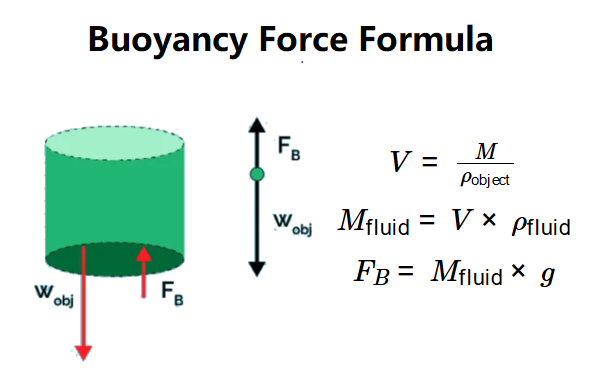1. What is Buoyancy Force Calculator?
Definition: This calculator computes the mass of the displaced fluid (\( W \)) and the buoyant force (\( B \)) acting on an object immersed in a fluid, using the buoyancy formulas.
Purpose: It is used in physics and engineering to determine the mass of fluid displaced by an object and the upward force exerted by the fluid, helping to understand floatation and stability.
2. How Does the Calculator Work?
The calculator uses the following formulas:
- \( W = \rho \times V \)
- \( B = \rho \times V \times g \)
Where:
- \( \rho \): Density of the liquid (kg/m³);
- \( V \): Volume of the displaced liquid (m³);
- \( g \): Gravitational acceleration (m/s²);
- \( W \): Mass of the displaced fluid (kg);
- \( B \): Buoyant force (N).
Steps:
- Choose the fluid density by selecting a fluid or entering a custom density with its unit.
- Enter the volume of the displaced liquid (\( V \)) with its unit.
- Enter the gravitational acceleration (\( g \)) with its unit (default is 9.81 m/s²).
- Convert all inputs to base units (kg/m³ for density, m³ for volume, m/s² for gravity).
- Calculate the mass of displaced fluid: \( W = \rho \times V \).
- Calculate the buoyant force: \( B = \rho \times V \times g \).
- Convert the results to the selected output units and display them, formatted in scientific notation if the absolute value is less than 0.001, otherwise with 4 decimal places.
3. Importance of Buoyancy Force Calculation
Calculating the mass of displaced fluid and buoyant force is crucial for:
- Floatation Analysis: Determining the mass displaced helps calculate the buoyant force, which indicates whether an object will float or sink, essential for designing ships, submarines, and buoys.
- Engineering Applications: Understanding the forces acting on submerged structures like pipelines or underwater equipment.
- Physics Experiments: Studying the principles of fluid mechanics and buoyancy in educational settings.
4. Using the Calculator
Example 1: Calculate \( W \) and \( B \) for an object in seawater with the following properties:
- Fluid: Seawater (\( \rho = 1025 \, \text{kg/m}^3 \));
- Volume of Displaced Liquid: \( V = 0.5 \, \text{m}^3 \);
- Gravitational Acceleration: \( g = 9.81 \, \text{m/s}^2 \);
- Mass of Displaced Fluid: \( W = 1025 \times 0.5 = 512.5 \, \text{kg} \);
- Buoyant Force: \( B = 1025 \times 0.5 \times 9.81 = 5027.625 \, \text{N} \);
- Result: \( W = 512.5000 \, \text{kg} \), \( B = 5027.6250 \, \text{N} \).
Example 2 (Custom Density and Units): Calculate \( W \) and \( B \) for an object in a custom fluid with the following properties:
- Fluid Density: \( \rho = 1.2 \, \text{g/cm}^3 \);
- Volume of Displaced Liquid: \( V = 500 \, \text{cm}^3 \);
- Gravitational Acceleration: \( g = 32.174 \, \text{ft/s}^2 \);
- Convert units: \( \rho = 1.2 \times 1000 = 1200 \, \text{kg/m}^3 \), \( V = 500 \times 10^{-6} = 0.0005 \, \text{m}^3 \), \( g = 32.174 \times 0.3048 = 9.8066 \, \text{m/s}^2 \);
- Mass of Displaced Fluid: \( W = 1200 \times 0.0005 = 0.6 \, \text{kg} \);
- Buoyant Force: \( B = 1200 \times 0.0005 \times 9.8066 = 5.8840 \, \text{N} \);
- Result (in selected units, e.g., lb, lbf): \( W = 1.3228 \, \text{lb} \), \( B = 1.3225 \, \text{lbf} \).
5. Frequently Asked Questions (FAQ)
Q: What does the mass of displaced fluid represent?
A: The mass of displaced fluid (\( W \)) is the mass of the fluid displaced by the object, which directly relates to the buoyant force through the gravitational acceleration.
Q: Why does the buoyant force depend on the mass of displaced fluid?
A: The buoyant force is the weight of the displaced fluid, which is the mass of the displaced fluid (\( W \)) multiplied by the gravitational acceleration (\( g \)).
Q: Can this calculator be used for gases?
A: Yes, the buoyancy formula applies to any fluid, including gases. However, the density of gases is much lower than liquids, resulting in a smaller mass of displaced fluid and buoyant force.
Buoyancy Force Calculator© - All Rights Reserved 2025
 Home
Home
 Back
Back
